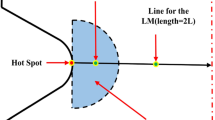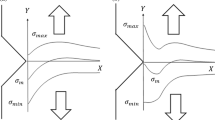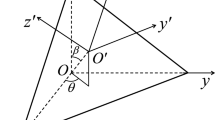Abstract
The methodology of probabilistic fatigue life prediction for notched components based on smooth specimens is presented. Weakestlink theory incorporating Walker strain model has been utilized in this approach. The effects of stress ratio and stress gradient have been considered. Weibull distribution and median rank estimator are used to describe fatigue statistics. Fatigue tests under different stress ratios were conducted on smooth and notched specimens of titanium alloy TC11. The proposed procedures were checked against the test data of TC11 notched specimens. Prediction results of 50 % survival rate are all within a factor of two scatter band of the test results.
Similar content being viewed by others
References
J. W. Fash, D. F. Socie and D. L. McDowell, Miller KJ, Brown MW, editors, Multiaxial Fatigue, ASTM STP 853, Philadelphia, ASTM (1985) 497–513.
H. Neuber, Theory of stress concentration for shear-strained prismatic bodies with arbitrary nonlinear stress-strain laws, Journal of Applied Mechanics, Transactions ASME, 28 (4) (1961) 544–550.
R. E. Peterson, Metal Fatigue, Hill McGraw, New York (1959) 293–306.
A. Wormsen, B. Sjödin, G. Häregärd and A. Fjeldstad, Nonlocal stress approach for fatigue assessment based on weakest-link theory and statistics of extremes, Fatigue & Fracture of Engineering Materials & Structures, 30 (2007) 1214–1227.
D. Taylor, The theory of critical distances, Engineering Fracture Mechanics, 75 (2008) 1696–705.
L. Susmel and D. Taylor, An elasto-plastic reformulation of the theory of critical distances to estimate lifetime of notched components failing in the low/medium-cycle fatigue regime, ASME Journal of Engineering Material and Technology, 132 (2) (2010).
Y. Yamashita, Y. Ueda, H. Kuroki and M. Shinozaki, Fatigue life prediction of small notched Ti-6Al-4V specimens using critical distance, Engineering Fracture Mechanics, 77 (2010) 1439–1453.
X. G. Yang, J. K. Wang and J. L. Liu, High temperature LCF life prediction of notched DS Ni-based superalloy using critical distance concept, International Journal of Fatigue, 33 (11) (2011) 1470–1476.
D. Lanning, T. Nicholas and G. Haritos, On the use of critical distance theories for the prediction of the high cycle fatigue limit stress in notched Ti-6Al-4V, International Journal of Fatigue, 27 (2005) 45–57.
G. Schweiger and K. Heckel, Size effect in randomly loaded specimens, International Journal of Fatigue, 8 (4) (1986) 231–234.
D. B. Lanning, T. Nicholas and A. Palazotto, HCF notch predictions based on weakest-link failure models, International Journal of Fatigue, 25 (3) (2003) 835–841.
W. Weibull, A statistical distributions function of wide applicability, Journal of Applied Mechanics, 9 (1951) 293–297.
N. E. Dowling, Mean stress effects in strain-life fatigue, Fatigue & Fracture of Engineering Materials & Structures, 32 (2009) 1004–1019.
L. F. Zhang, M. Xie and L. C. Tang, A study of two estimation approaches for parameters of Weibull distribution based on WPP, Reliability Engineering and System Safety, 92 (2007) 360–368.
Author information
Authors and Affiliations
Corresponding author
Additional information
Recommended by Associate Editor Jun-Sik Kim
Z. R. Wu, born in 1984, is currently a Postdoctor in Department of Engineering Mechanics, Southeast University, Nanjing, Jiangsu, China. He received his Ph.D. degree from Nanjing University of Aeronautics and Astronautics, China, in 2014. His research interests include fatigue and durability of components and structures.
Rights and permissions
About this article
Cite this article
Wu, Z.R., Hu, X.T., Li, Z.X. et al. Probabilistic fatigue life prediction methodology for notched components based on simple smooth fatigue tests. J Mech Sci Technol 31, 181–188 (2017). https://doi.org/10.1007/s12206-016-1219-x
Received:
Revised:
Accepted:
Published:
Issue Date:
DOI: https://doi.org/10.1007/s12206-016-1219-x




